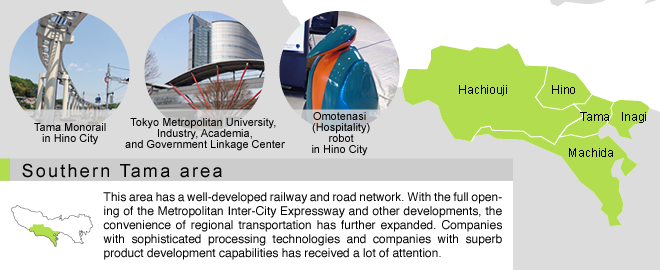 Southern Tama area
Southern Tama area
 Area Features
Area Features
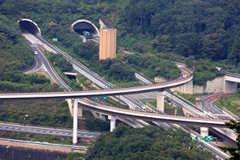 Takaosan IC, Ken-O Expressway
Takaosan IC, Ken-O Expressway
This area is adjacent to Kanagawa Prefecture and Yamanashi Prefecture. In the hilly area, precious assets of the national capital region such as “satoyama,” Japan’s socio-ecological production landscape, and countryside landscapes still remain.
This area has a well-developed railway and road network, but with the full opening of the Metropolitan Inter-City Expressway and other developments, the convenience of regional transportation has expanded.
Hachioji City has the largest population among Tokyo’s cities, towns and villages, and Tama City has a very striking population growth rate.
 Manufacturing Industry Features
Manufacturing Industry Features
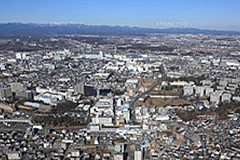 Kita-Hachiouji industrial park
Kita-Hachiouji industrial park
The South Tama area, which has a large concentration of companies with sophisticated processing technologies and companies with superb product development capabilities, ranks top among all the areas in the Tokyo metropolis in value added. Particularly, Hino City is an “industrial town,” ranking second among Tokyo’s municipalities in annual product shipment and first in value added.
Hachioji City, which has many industrial parks, also has research institutions of major corporations and many universities, making it an area blessed with industrial resources and human resources.
 Support Facilities and Property Situation
Support Facilities and Property Situation
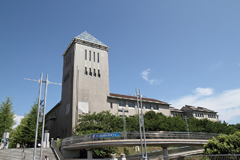 Tokyo Metropolitan University
Tokyo Metropolitan University
There are also many universities and research institutions engaging in the development of cutting-edge technologies.
Of the 137 universities in Tokyo, 21 are located in the South Tama area, and some 100,000 students are studying there.
The Tokyo Metropolitan University is an incorporated municipal university established by the Tokyo Metropolitan Government in April 2005. Its Liaison Office aims to broadly return the university’s academic research accomplishments to society, and through collaboration with the industrial sector and public research institutions, contribute to the development of innovative technologies and products.
 Basic Data
Basic Data
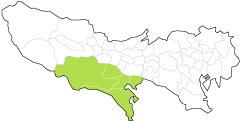
| Municipalities |
|---|
| Hachiouji, Hino, Machida, Tama, Inagi |
| Population |
Number of establishments in manufacturing business |
Number of employees in manufacturing business |
Shipment value
(unit: ten million yen)
|
Added value
(unit: ten million yen)
|
|
|---|---|---|---|---|---|
| Hachioji | 563,178 | 991 | 15,599 | 37,942 | 18,156 |
| Hino | 184,667 | 126 | 14,691 | 81,120 | 45,642 |
| Machida | 428,742 | 277 | 5,944 | 13,034 | 5,571 |
| Tama | 148,724 | 46 | 1,150 | 3,295 | 1,274 |
| Inagi | 89,915 | 134 | 1,892 | 2,990 | 1,343 |
| total of this area | 1,415,226 | 1,574 | 39,276 | 138,381 | 71,986 |
| total of Tokyo | 13,637,346 | 27,142 | 296,132 | 854,522 | 338,191 |
Source:
・Ministry of Internal Affairs and Communications, "Basic resident register", 2018/1/1
・Industry and Employment in TOKYO 2018, Bureau of Industrial and Labor Affairs, Tokyo Metropolitan Government


